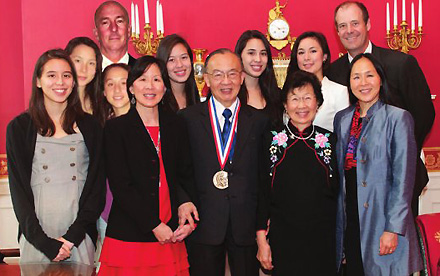A Humble Man in Tireless Pursuit
By Jessica P. Johnson
NOTE: This is an abstract of the entire article, which appeared in the March/April 2012 issue of the IEEE Pulse magazine.
Click here to read the entire article.
During his career that has spanned more than 50 years and two continents, Chien was one of the first physiologists of his time to apply engineering principles to understanding biological systems. He has explained the physics behind how red blood cells travel through vessels, detailed how the stress of blood flow against the endothelial cells lining vessel walls can cause cardiovascular disease, and investigated the optimal growth conditions for stem cells used in regenerative medicine. He started out as a physician, obtaining his M.D. degree from National Taiwan University, but later pursued his Ph.D. degree in physiology at Columbia University. Chien felt that switching to a research career would offer more opportunities to be creative and to test innovative ideas. He spent nearly 30 years, first as a student and then a professor of physiology and biophysics, at Columbia before he was recruited, at the age of 57, to the bioengineering program at the University of California at San Diego (UCSD). Within six years, he transformed the program into its own department, serving as a founding chair and amassing US$18 million in funding from the Whitaker Foundation and matching funding from other sources to construct the first UCSD building with the name bioengineering on its edifice. The department now ranks first in the nation, according to the National Research Council.
The length of Chien’s list of awards and honorary memberships rivals that of his publications. In addition to being an honorary member of the IEEE Engineering in Medicine and Biology Society (EMBS), he has the distinction of being one of only 11 living people elected to all three national academies: the National Academy of Engineering, Institute of Medicine, and National Academy of Sciences. He is also a member of the American Academy of Arts and Sciences, the oldest scientific academy in the United States. To top the list, President Obama awarded him the 2010 National Medal of Science, the nation’s top award to scientists and engineers.

Chien with his family at the 2010 National Medal of Science Award cevemony on 21 October 2011.
While at Columbia, Chien wasted no time, publishing an average of nine papers per year. In 1967, three of these appeared in the same issue of Science magazine. His studies revealed how the deformability of red blood cells allows them to squeeze through tiny capillaries, and Chien was the first to identify the mechanical and biochemical factors that control this unique cellular characteristic. Chien later applied these basic biological concepts to understand diseases such as sickle-cell anemia, in which red blood cells lose their flexibility, become rigid, and disrupt normal blood flow.
At UCSD, Chien then expanded his scope to diseases of the vascular system linked to blood flow, including atherosclerosis and hypertension. He first focused on endothelial cells that line the inner surface of blood vessels and respond to shear stresses caused by blood flow. He identified how mechanical forces, such as pressure and flow, impact molecular signaling inside the cells and, ultimately, gene expression, that determines whether a cell will grow, migrate, or die. He discovered that diseases such as atherosclerosis – in which vessel walls thicken in response to accumulations of white blood cells, smooth muscle cells, and fatty deposits such as cholesterol – occur most frequently at points where vessels branch. He translated this work into recommendations for treatments and the prevention of stroke and heart disease and also how blood vessels should be connected during surgery to minimize atherosclerotic plaque buildup.
In all of his work, Chien takes a multidisciplinary approach, combining engineering and physiology principles, and never hesitates to incorporate the most advanced technologies as they evolve in molecular biology, nanotechnology, and biomechanics. His research begins at the cellular level and progresses to the tissue, organ, and systems levels. Most recently, he has devised a high-throughput approach to investigating a proper combination of proteins such as fibronec- tin and collagen in the extracellular matrix surrounding stem cells that cause them to either grow or differentiate into bone, brain, liver, heart, pancreas, or blood vessel cells.
Chien’s friends and colleagues use superlatives not only when speaking about his contributions to bioengineering but also about his character. “With some people you get the sense that their ego drives them to do what they’re doing. With Dr. Chien that’s never the case,” says Kirk Knowlton, chief of cardiology at UCSD and codirector of the institute’s Cardiac Biological Science and Engineering Center. “The reason he’s doing this is to contribute to our knowledge of medicine and science. He’s a role model and an outstanding leader – probably beyond compare.”
In June 2011, Chien turned 80, and was once again presented with a book of tributes. If anyone had illusions about his plans for retirement at his 70th birthday, it is unlikely that they have them now. “I have never heard Shu talk about retiring,” says Palsson. “The only thing he said to me a few years ago was, ‘It’s probably not right for me to be the chair of the department anymore,’ which I took to mean, ‘I have bigger fish to fry’.” His colleagues are looking forward to what Chien will produce in the next decade.
ABOUT THE AUTHOR
Jessica P. Johnson (jpjsciencewriter@gmail.com) is a freelance science writer and graduate of Boston University’s Center for Science and Medical Journalism.






